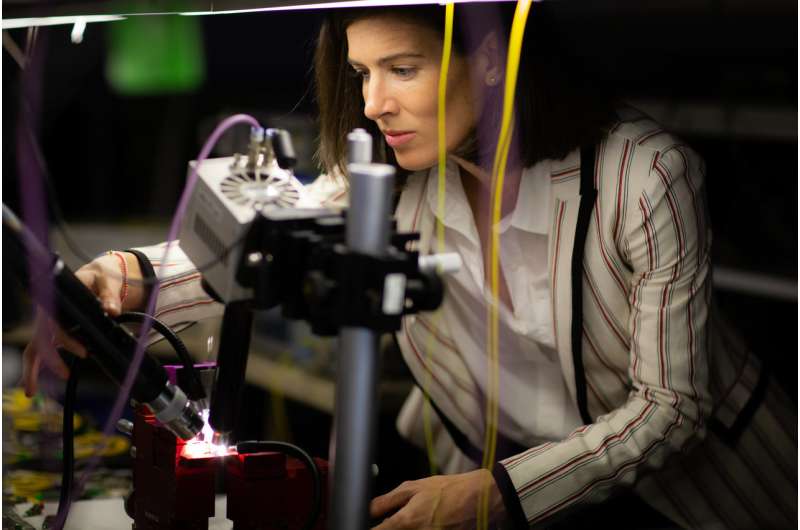

| Date | 1st, Nov 2018 |
|---|
 Lead author Dr Andrea Blanco-Redondo in her photonics laboratory at the Sydney Nanoscience Hub at the University of Sydney. Credit: Jayne Ion/University of Sydney
Lead author Dr Andrea Blanco-Redondo in her photonics laboratory at the Sydney Nanoscience Hub at the University of Sydney. Credit: Jayne Ion/University of Sydney
Scientists in Australia have for the first time demonstrated the protection of correlated states between paired photons—packets of light energy—using the intriguing physical concept of topology. This experimental breakthrough opens a pathway to build a new type of quantum bit, the building blocks for quantum computers.
The research, developed in close collaboration with Israeli colleagues, is published today in the prestigious journal, Science, a recognition of the foundational importance of this work.
"We can now propose a pathway to build robust entangled states for logic gates using protected pairs of photons," said lead author Dr. Andrea Blanco-Redondo at the University of Sydney Nano Institute.
Logic gates are the switches needed to operate algorithms written for quantum computers. Classical computational switches are in simple binary forms of zero or one. Quantum switches exist in a state of 'superposition' that combine zero and one.
Protecting quantum information long enough so that quantum machines can perform useful calculations is one of the biggest challenges in modern physics. Useful quantum computers will require millions or billions of qubits to process information. So far, the best experimental devices have about 20 qubits.
To unleash the potential of quantum technology, scientists need to find a way to protect the entangled superposition of quantum bits—or qubits—at the nanoscale. Attempts to achieve this using superconductors and trapped ions have shown promise, but they are highly susceptible to electromagnetic interference, making them devilishly difficult to scale up into useful machines.
The use of photons—packets of light energy—rather than electrons has been one proposed alternative upon which to build logic gates that can calculate quantum algorithms.
Photons, unlike electrons, are well isolated from the thermal and electromagnetic environment. However, scaling quantum devices based on photonic qubits has been limited due to scattering loss and other errors; until now.
"What we have done is develop a novel lattice structure of silicon nanowires, creating a particular symmetry that provides unusual robustness to the photons' correlation. The symmetry both helps create and guide these correlated states, known as 'edge modes'," said Dr. Blanco-Redondo, the Messel Research Fellow in the School of Physics.
"This robustness stems from the underlying topology, a global property of the lattice that remains unchanged against disorder."
The correlation this produces is needed to build entangled states for quantum gates.
